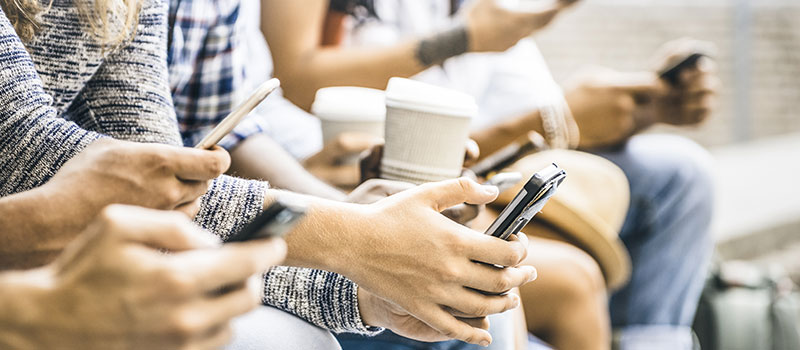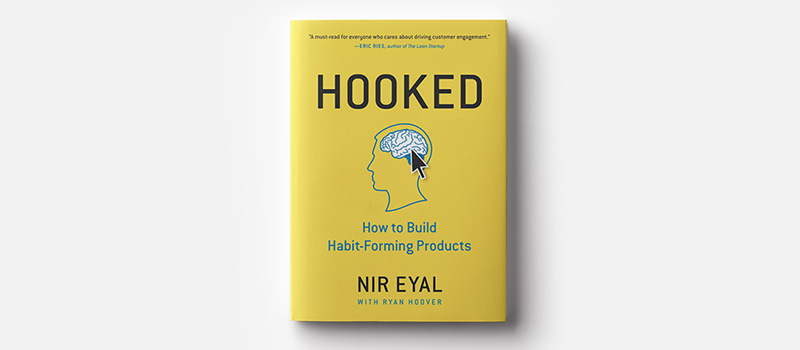I had the chance to talk with Nir Eyal about how to build habit forming products and brands with hooks and triggers to keep customers coming back and spending more.
Now Nir Eyal is an author and lecturer known for his expertise in the psychology of habit-forming technology. He wrote the bestselling book "Hooked: How to Build Habit-Forming Products" and is an active speaker and consultant on behavioral design and habit formation.
And in our chat today we dive into
How brands can trigger habits to keep customers coming back
How To Use Rewards To Keep Customers Engaged
How Revenue Is A By-product Of Something More Important
So, if you want to learn from an expert in behaviour design and habit formation about how to trigger your customers can keep them coming back
How Can Brands Create Products That Customers Habitually Use?

Stephen
Just quickly, could you give us a bit of background on how you ended up in this very interesting space?
For me, I'm passionate about everything branding.
At the center of that is human psychology and understanding why people do what they do.
It's probably the most interesting part of what I do. How did you end up in the field that you're in?
As a boy, I don't think you grow up with these specified ideas of what you're going to end up doing.

Nir Eyal
It depends how far back you want to go.
I would say that my fascination with brands and marketing actually started, believe it or not, when I was very young.
I used to be clinically obese from a pretty young age. I remember my mom taking me to the doctor, and the doctor had this chart on the wall that showed the green zone for normal weight, the yellow zone for overweight, and then there was the red zone, where I was, labeled as obese.
For a good chunk of my life, I felt like food controlled me.
It wasn't until I was exposed to what they used to call 'being a smart shopper' on television shows that educated kids on how consumers behave.
Now we call it consumer psychology.

I remember getting my first taste of how marketers often use psychology to change human behavior. I learned from a young age about why, on the box of cereal I used to love, Trix, the Trix rabbit was always looking down.
It's said that the rabbit looks down so that when the box is on the shelf, children look up and immediately see the rabbit looking back at them.
I became really fascinated by how companies can influence human behavior.
When I lost the weight, I felt very empowered by the fact that even though those marketing tricks were effective, they weren't that good.
It gave me a lot of confidence for what I do today, which is using consumer psychology for good, trying to help people build healthy habits rather than destructive ones.
PRO Brand Strategy BluePrint
Build Brands Like A Pro Brand Strategist

How Can Brands Trigger Positive Customer Habits?

Stephen
I'm not an expert in consumer psychology, but I do talk a lot about branding and consumer psychology.
I've made videos on the subject, and in the comments, some people accuse me of trying to manipulate others by discussing this discipline.
However, I talk about it because it exists and it's part of what we do in branding.
When you say you're trying to use this power for good, what exactly is your mission?
Is it to provide this information to people so they can make better choices at checkout, or to help them understand what's going on in the market so they're more empowered?

Nir Eyal
No, I want people to feel empowered, starting with the makers.
That's really my audience. When I wrote Hooked: How to Build Habit-Forming Products, my first book, it was clearly marketed towards people who lead brands, build consumer experiences, design user interfaces, and anyone who has a business that needs people to keep coming back.
The ethical framework I provide is that manipulation on its own has a bad connotation, but I would argue that it's not a bad thing at all.
Manipulation is a neutral term.
In fact, I'll prove it to you.
We pay for the privilege of being manipulated all the time.
If you go into a movie theater, you know that it's just flickering light on a screen. Those aren't real people having real experiences; they're actors. We know that, but we will pay for the privilege to have our emotions manipulated.
Brands very much create the experience.
This isn't just hand-waving. We know that the placebo effect is at the core of all marketing. We can actually make people like stuff more when it has brand cachet, when there is price information given.
Based on these criteria, people will actually enjoy the experience more. They won't just tell you they enjoy it more or just pay more for it. Their brains are actually experiencing something different when they believe there's something unique about the product as conveyed through the brand.
So, manipulation on its own is not bad because there are two kinds of manipulation. It's very important we differentiate.
I would argue that ethical manipulation is called persuasion.
Persuasion fundamentally is helping people do things that they themselves want to do. So my job is to steal the secrets of the advertising companies, the gaming companies, the social media companies. I stole their secrets and tried to democratize them so that we can use the same psychology that makes Facebook, TikTok, Amazon, Google, Slack, Snapchat, all of these things that are so habit-forming, so sticky, so engaging.
How can we steal those secrets so that we can make products like Duolingo, one of my first clients?
How can we make Duolingo something that gets people hooked on learning a new language, or FitBot, a case study in the book, a product that gets people hooked on exercise?
We can use these same exact tactics for good in every conceivable industry to bring people back to help them do things they want to do.
Right. Nobody's getting unhealthily addicted to enterprise SaaS software. The majority of people out there who are building products, their problem is not that people are overusing their products or that they're manipulating anybody.
They just would pray that somebody would use the product, that the product is great if people would just use it. And so that's really the kind of work I do is to help people do the things that they themselves want to do, but for lack of good product design, don't do. So that's persuasion.
The opposite of persuasion is coercion, and coercion is unethical.
Coercion, unlike persuasion, which is helping people do things they want to do, coercion is about getting people to do things they did not want to do. That's coercion. That's the unethical side of manipulation.
We would never want to do that. One, it's unethical, right? But two, it's bad for business.
Because in this day and age, if you trick people into doing something, if you coerce them into doing something, not only are they not going to do business with you ever again, they're going to go on social media and tell all their friends never to do business with you either.
So it's not that you can't make money with coercive products. You know, we call these dark patterns. You can make money, but you probably won't be in business for very long because customers won't keep coming back to you if they feel like they've been tricked.
So the difference between persuasion and coercion is one simple word, and that one word is regret.
And so this is why I offer in much of my writing, I've talked quite a bit over the past 15 years about what I call the regret test.
The ultimate test of whether you are doing something ethically, using one of these psychological tactics to influence people to manipulate them, are you doing it ethically, is about would the user regret having done what they just did.
And if the answer is yes, they would regret it, don't freaking do it. It's unethical and it's bad for business. But if people said, you know what? I'm glad you manipulated me into exercising more. I'm glad you manipulated me and persuaded me into learning a new language.
I'm glad that you helped me become healthier, happier, more connected, whatever the case might be. Great. We should be doing more of that.
In fact, I think it's unethical not to help persuade
How Brands Reach and Help Customers Achieve Goals?

Stephen
How can brands integrate themselves into the daily habits of their customers by leveraging positive persuasion to help them overcome challenges?
Given the importance of providing solutions for the target audience's problems, it's crucial to understand the distinction between manipulation, persuasion, and coercion.
As a brand strategist, how do you see the ethical role of persuasion in guiding customers toward solutions that address their challenges and problems?

Nir Eyal
In today's competitive market, having a distinctive advantage is crucial. Warren Buffett famously referred to this as a "competitive moat," which can manifest in various forms.
Intellectual property, such as a brand name or logo, is a common form of this moat. However, building a brand like Coca-Cola requires significant investment, often beyond the reach of smaller companies.
Technological innovation and economies of scale are other avenues to achieve a competitive edge.
Without such an advantage, businesses risk being undercut on price and features, leading to eroding margins.
One of the most cost-effective competitive moats is cultivating customer habits. Google's dominance in the search engine market, with around 89% share, exemplifies this.
The term "Google" has become synonymous with searching online, a habit ingrained in users' minds. This "monopoly of the mind" means that even though head-to-head comparisons with competitors like Bing show no clear superiority, users continue to default to Google out of habit.
Building this kind of habit is a long-term investment that can't be bought; it must be woven into the user experience from the beginning.
The Hook Model, consisting of four steps, is a framework for creating products that naturally encourage user habits.
This model can be applied both in the early stages of product development and later to enhance the stickiness of an existing product.
By diagnosing and addressing gaps in the Hook Model, companies can increase the likelihood that their products become habitual for users, securing a lasting competitive advantage.
Explore Brand Strategy
Programs & Tools
Hooked: How to Build Habit-Forming Products Book Overview

In his comprehensive guide, Nir Eyal explains the Hook Model, a four-step process designed to create habit-forming products.
The first step is the external trigger, which prompts action through cues in the environment, like notifications or billboards.
The action phase follows, where the user performs a simple behavior in anticipation of a reward, such as opening an app or scrolling a feed.
The key here is to reduce friction to encourage repeated engagement.
The third step is the variable reward phase, where users find what they're looking for but with an element of uncertainty.
This unpredictability is a crucial component in habit-forming products, as it creates a sense of intrigue and compels users to return.
The final step, the investment phase, is where users contribute to the product, enhancing its value with each use.
This is particularly significant with the rise of AI, as personalized experiences based on user data will become a competitive advantage.
Eyal emphasizes that the ultimate goal of a habit-forming product is to transition from external to internal triggers. When users start using a product not out of necessity but because they want to, driven by internal emotional states like boredom or loneliness, a habit is formed.
This shift from external prompts to internal motivation is the hallmark of a successful habit-forming product, creating immense economic value by fostering user engagement without reliance on constant notifications or advertising.
What Role Do Rewards Play In Customer Loyalty?

Variable rewards are a crucial aspect of habit formation in consumer behavior. There are three types of variable rewards:
Rewards of the tribe,
Rewards of the hunt,
Rewards of the self.
Most businesses are familiar with rewards of the hunt, which involve the search for material resources such as money and information.
This is often seen in loyalty programs that offer discounts, essentially buying customers.
However, this approach can be intellectually lazy and expensive, as discounts directly reduce profits.
Moreover, customers may become habituated to expect rewards, leading to a situation like the Bed Bath & Beyond effect, where customers only shop with a coupon, attracting a clientele that is not profitable.
Unlike rewards of the hunt, rewards of the tribe offer social rewards.
Humans are social beings who care about their relationships and standing within their community. Connecting people can be a powerful motivator, as seen in the Hallmark Keepsake Ornament Club.
Members join not just for the ornaments but for the social interactions with other enthusiasts. This sense of belonging and community drives engagement without any material cost.
Rewards of the self focus on the need for competency, mastery, and control.
Examples include the satisfaction derived from advancing levels in games like Candy Crush or Angry Birds. These rewards cost nothing in terms of material value but can be highly effective in creating habit-forming products.
In summary, while rewards of the hunt are commonly used in loyalty programs, rewards of the tribe and rewards of the self offer alternative, cost-effective ways to engage customers.
By understanding and leveraging these different types of rewards, businesses can create more sustainable and profitable strategies for customer engagement.
How Can Setting Clear Goals Improve Focus And Productivity?

Monetization is a result of engagement, not the other way around.
This mantra is especially true in e-commerce, where companies often focus on getting people to check out but miss the opportunity to get them to check in.
The key to success is to get people to participate, consume content, and activate in your community, building habits around your product.
When it comes time to check out, the result of this engagement will be monetization.
Building a habit-forming product is crucial, and viewing the transaction as a byproduct allows you to focus on other engagement-building activities. Like any relationship, it's essential to invest, nurture, and then reap the rewards later on.
Brand communications play a vital role in this process, and it's important to make them compelling rather than overwhelming.
Brands need to use paid triggers sparingly and focus on direct response advertising, as it's more cost-effective than brand advertising, which requires a significant investment to change user perception through the mere exposure effect.
The experience itself is changing customer perception, with the most valuable companies spending proportionally the least amount on advertising.
They rely on the product experience to build brand affinity, making it crucial to hook customers as soon as they try the product.
It's much cheaper to retain existing customers than to acquire new ones, yet many brands focus on top-of-funnel activities and neglect to make their product stickier.A leaky bucket, where customers try the product but never return, is a common problem.
The hook model is a diagnostic tool to identify what's broken in the product.
It involves understanding the internal trigger that brings people back, the external trigger that prompts action, the simplicity of the action in anticipation of reward, and the fulfillment of the reward that leaves the user wanting more.
By asking these fundamental questions, brands can diagnose and correct deficiencies in their product, leading to more effective engagement and monetization.
On-Demand Digital Program
Brand Master Secrets
Make the transition from hired-gun to highly valued brand strategist in less than 30 days. The systems, frameworks and tools inside this comprehensive program are all you need to level up.












